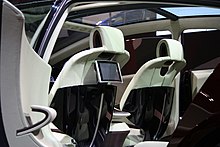Car interior
The passenger area of a motor vehicle is referred to as the interior . It includes the enclosed space with its internal dimensions as well as the interior cladding, seats , benches ( generally rear bench ), dashboard , other fittings and controls. The trunk is also added.
The interior can be closed ( sedan , station wagon ) or open ( convertible ).
A motorcycle has i. A. no interior, unless it is a cabin scooter ; a truck can have a reclining area behind the seats. Its interior is also called the driver's cab, driver's cab or driver's cab . A coach has instead a so-called a trunk. Luggage compartment (also: luggage compartment), the i. A. is not counted as part of the interior.
Internal dimensions
The size of the interior is v. a. depending on the intended use ( market segment ) for which the vehicle is designed. In cars , 1, 2 or 3 rows with 2–3 seats each are common, in trucks only one row. The body dimensions of an above-average person as well as the usual sitting posture have to be taken into account, which makes "closed" cars under approx. 110 cm high impossible.
design
As the direct environment for the driver and front passenger, the interior is the essential experience area . Its design ( design ) is thus for the car manufacturer of very high importance. The interior is designed in particular in the following areas:
- User ergonomics : arrangement, shape and accessibility of all operating elements ( steering wheel , pedals , switches, buttons, other elements) as well as all information conveyors (displays, signal lamps)
- Seating ergonomics : upholstery and shape, spring stiffness , heating / cooling, degrees of freedom of adjustment
- Color design / coloring
- Shaping
- Haptics : roughness, smoothness, grain of surfaces
- Noise design: noise insulation to the engine compartment , to the wheel houses , to the environment; Selection of signals to the driver; Operating noises (door closing, etc.), radio / sound system
- odor
- Heating / air conditioning: air circulation flow paths
In these design disciplines , the manufacturer tries to adapt the interior as far as possible to the usual wishes of the target group of buyers, whereby the production costs must also be taken into account.
See also
Web links
- Car interior As cozy as your own living room (accessed February 11, 2016)
- Car interior of the future (accessed on February 11, 2016)
- Pollutants in the car interior (accessed on February 11, 2016)


